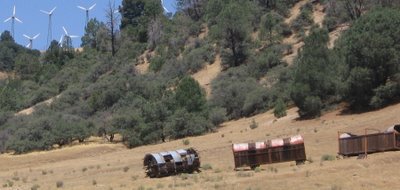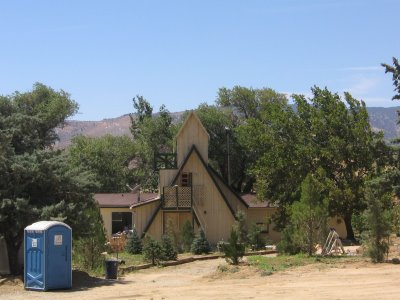Wednesday, September 06, 2006
Hunting chupacabra in the high desert

August 17:
We’re standing on an empty road in the hills outside Tehachapi. It’s after midnight and the only lights come from the odd little A-frame in the ranch compound below us and the weird neon blue strobes coming from the forests of gargantuan wind turbines in the distance. The monolithic windmills closer to the compound have no strobe beacons. Their silhouettes tower over Heaven Ranch, blades crying eerily through the night.
We’re about to cross the road and climb a hill toward what our companions are calling an old abandoned slaughterhouse, but we’ve paused because the daughter of Rowdy Roddy Piper is getting second thoughts about leaving the relative safety of the ranch.
I find this a little strange, since she has been vocal about her outdoorsy life in Oregon, but given the reason she’s here at this small compound in the high desert, it makes sense that everyone is a little on edge.
They’re filming a horror movie. Tonight we’re hunting el chupacabra.
Val’s friend is making jokes that since the two of us are the most recent arrivals, we haven’t bonded with the “audience” yet and will be the first two disemboweled by the beast. The Piper’s daughter, a healthy-looking blonde girl of about 20, is remembering all the ghost stories the crew has been telling—about the man who committed suicide in the mobile home where Val and I will sleep tonight, about the little girl who long ago drowned in the gully below the compound when a flash flood tore through the hills and half-buried the graveyard of stolen, stripped cars; how the director once saw her and ordered her to help carry out some equipment, thinking she was his own young daughter.
Her companion, a young man with an enigmatic accent and a movie role, is trying to exploit this as we stumble over a barb-wire fence and weave carefully around the larger tufts of scrub where we’re convinced nests of rattlesnakes slumber.
Val’s other friend, J., mentions mountain lions, and all of a sudden giant cats are dueling it out with venomous snakes in my brain for terror primacy. I shine my flashlight carefully in front of Val’s feet, sure that at any moment I will see a shape that won’t register in my mind as a paw or a slithering tail until after everyone else has started screaming.
Cows graze on these hills, but we see none of them, only dried cow pies. This only increases my puma suspicions. Suddenly Val’s friend lets out a piercing scream and we hear feet shuffling in the loose dirt ahead. The events of the evening suddenly take on a fatal tone as I wonder who should have been leading the group, if we should have been out here with more flashlights, if I should have evaluated the circumstances before we left and been a wet blanket.
Then we hear Val’s friend cursing J. out for scaring her. We press on up the hill, climb over another fence and find a decrepit metal Quonset hut. We peer into it, “Blair Witch” style, to find there’s nothing there—no furniture, no floor, no graffiti. It’s truly empty. Next to the hut we find two decaying cattle trailers. They’re round-roofed wooden things, and they look like the abandoned wagons from a down-on-its-luck carnival.

Compelling scenery for a horror movie, but thorough investigation reveals no traces of any kind of human—or vampiric—occupation. This is the high desert.
***
Val and I arrived at the ranch a few hours earlier after driving from Butte County. The opening leg of our West Coast farewell tour would take us to San Diego, but Val’s best friend, working 16-hour days on the set in Tehachapi, told her she would have a few days off. We diverted there to visit her, not sure if we would stay at the set or the nearest hotel, not sure how near the nearest hotel would be.
I had been chugging caffeinated soda since we left Paradise at 2 p.m. By the time we got to Bakersfield and had dinner, I had switched to the backup: an 11-ounce can of Starbucks iced coffee we picked up in Sacramento. I was jittery and alienated. I was watching things happen through a tunnel. I no longer had to blink.
This was my first real road-trip experience as a licensed driver. My family had driven to San Luis Obispo occasionally when I was a child, but staring vacantly out a passenger window is a far cry from avoiding dually pickups with horse trailers and desperately trying to navigate a landscape seemingly forsaken by helpful road signs.
We had been driving for five or six hours before we stopped to refuel at a settlement that seemed to be nothing more than gas stations. Walking around the car and staring at the outline of the sun obscured by the pervasive haze, I already felt like I was a different person in a different land. Nobody lived here. None of the people milling into the AM-PM/Jack In The Box did, either. This is the anonymity of being elsewhere bound. Though there’s not a lot of hostility or malice in these situations, I doubt it’s because everybody’s really that benign. It’s likely a matter of conserving energy: getting to the destination is the priority, and after six hours in the car, you can’t spare much for hassling some other guy over a spot in the line to buy gasoline and Slim Jims. The fact that everybody on I-5 seems to drive interchangeable minivans and Chevy Tahoes doesn’t help that faceless feeling.
We got done with dinner knowing we were close, not knowing we would have to wind our way up a stupefyingly steep Highway 58 before we got to Tehachapi. I left the restaurant feeling a little like a victim of Convenience Store America for the day’s intake of calories and fat. Fearing obesity (and yes, being a stereotypical brand-obsessed, franchise-hound American), I am reluctant to live on the standard roadside diet of fast food and Cokes, but without a careful strategy (or the patience and focus to search out a supermarket after a hard day’s drive), this is the cuisine available. I like fast food enough to know it’s going to be a fight to keep from adopting these eating habits long term.
So up Highway 58 in the early darkness, flat at first, but then climbing and winding, the pink-orange glow of Bakersfield disappearing among the hills. We were surrounded by 18-wheelers gasping up the grade. I don’t know why such a grueling route is so traveled by cargo trucks, but they far outnumber the cars when the sun goes down. They’re in both lanes, some with hazard lights flashing, some flooring it, grinding those gears to get past the slower rigs.
Beaker has a four-speed automatic transmission. To climb hills, I try to keep the speed and the RPMs up to prevent it from downshifting. I don’t like the high drone of third gear, but this was a nightmare of a climb, up from the valley to 3,000 feet. Between the grade and the constant obstacle of trucks passing trucks at 30 mph, we took it in third.
Then, finally, the small town of Tehachapi. We passed through it and into the windmill hills, off to a road where Heaven Ranch is the first sign of civilization. Val’s friend got permission for us to sleep at the compound, so we drove through the tall wrought-iron arch and parked in the dirt, amid a smattering of mobile homes, travel trailers, trucks, and the well-landscaped A-frame.
She showed us our sleeping accommodations, a bedroom inside a mobile home on the outskirts of the compound. She shrieked when she opened the door and a mouse waddled away from the wastebasket in the living room. The dead man’s cat would probably take care of it, but she’s allergic to cats and keeps it outside.
Later, after meeting filmmaking mastermind David Heavener, hearing him sing a bluesy song about necrophilia, and then the chupacabra hunt, we bedded down and I started to write:
Three mattresses, all stolen from the same motel, no box springs, stacked together, are a bed. The trailer park princess and the pea.
We’re lying on a queen-size air mattress on the floor of a mobile home. It’s 3 a.m.—perfect time to be awake on the floor of a mobile.
The mobile is part of a small complex near Tehachapi, surrounded by the giant three-blade wind turbines that look friendly by day and ghostly by night. In this mouse-infested house—and several other trailers and homes—sleeps an entire film crew.
The complex is on a hillside speckled with scrub and debris. The buildings are similarly cluttered—old furniture, broken TVs, stairs to nowhere, stolen road signs. These things seem equally haphazard and yet they all seem like they could appear in the string of low-budget films that spew from the home-brew studio and its feverishly driven proprietor.
David lives in the A-frame house on the property.

A seemingly ageless, “been there” kind of guy, he writes, directs, stars in, scores and produces his films. He is also a martial arts expert and a Christian music recording artist.
Like the man himself, the house extends far past its humble exterior. As his films and ambitions have dictated, David has built on to the house, creating an M.C. Escher-esque labyrinth of white doors, arbitrarily shaped rooms and staircases to nowhere. A studio exists adjacent to this house, festooned with David’s movie posters and filled with used set pieces. Outside he has built a pond from an underground spring, presumably to expand his shooting locations.
His films are made in six weeks and then distributed by a major video store chain. “Straight to video,” a term synonymous in some circles with “factory second” or “thrift store,” is in this case the deliberate objective. Make a film for $10,000. Sell it to the video stores for between $50,000 and $250,000. Lather, rinse, repeat.
But it can be hard to repeatedly churn out movies on the cheap. Most actors crave meaty roles in tightly written scripts. And they want to be paid. Most crew members hate their jobs because they’re really paying their dues on the road to a director’s chair. And they want to be paid.
The more you develop your crew, the more compensation they expect. They expecxt to work in higher quality productions, too.
David manages to keep his costs down in several ways. First, he owns his own studio. Second, he doesn’t’ have to pay anyone for screenplays—he does it himself. Third, his actors perform double duty behind the camera as assistant directors, script readers and craft services.
Fourth and most importantly, he doesn’t pay them for either role.
David has harnessed the informational power of the Internet. Because of this, he gets his cast for free.
Experience has always been a hot commodity in moviemaking, a business in which untold numbers of projects go unfinished because they run out of funds or their creative leaders part ways or their creators just lose interest. Having a verifiable film credit to your name is like a merit badge, a permanent association with a project which, even if it tanked, actually saw the light of day. A film credit is an endorsement. While this has always been so, verifying it was much more difficult before the Internet. The Internet Movie Database stores information on nearly every movie ever made (and officially distributed). Even straight-to-video movies show up there. David should know. He’s got more than 25 entries.
While the Internet is a lure to fresh talent, David also finds it a useful medium for revenue. He advertises for crew on craigslist.org, but he also gets the chance to select potential cast members when people sign up for his $75 acting seminars (“Wrote, directed and starred in over 25 films!”), held in his private studio.
Apart from the cast, everything gets recycled—set pieces, wardrobe, locations—with no room for perfectionism. David has his house rebuilt for each shoot. Amateur actors perform their best while trying to keep the shambolic production afloat, compromises piled atop compromises like so many mattresses, until there’s 100 minutes of movie. But it gets done.
Somebody must rent these films. The distribution contracts don’t pay David for units rented, of course, but people must rent the movies for the stores to keep paying him for his product. And don’t tell me it’s a bunch of irony-minded twentysomethings looking to play “Mystery Science Theater 3000.” I don’t believe that’s the target audience.
When they reach the shelves, some shell-shocked consumer must reach out a numb hand and grab the drab jewel case. The thing is, we exist in a branded world. Brands define our culture. We feel more comfortable with name-brand soda, name-brand cereal, even the name-brand electronics that play our entertainment.
And certainly our celebrities are brands, with their own marketing schemes and demographic appeal. So who is left anywhere who would earnestly consume these generic products? For the same price as a recognizable brand, who would take this off the shelf?
